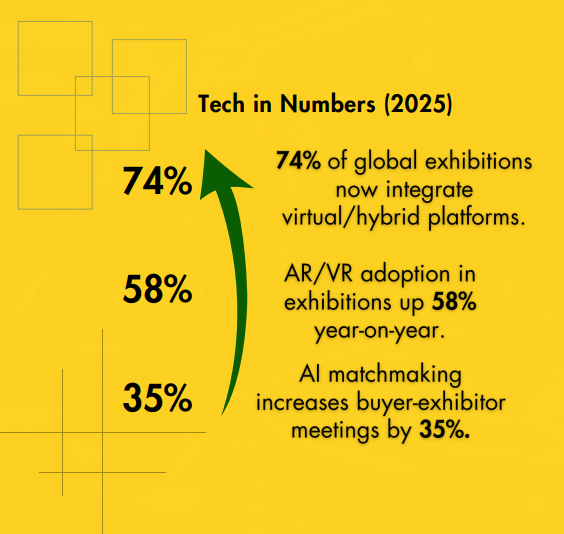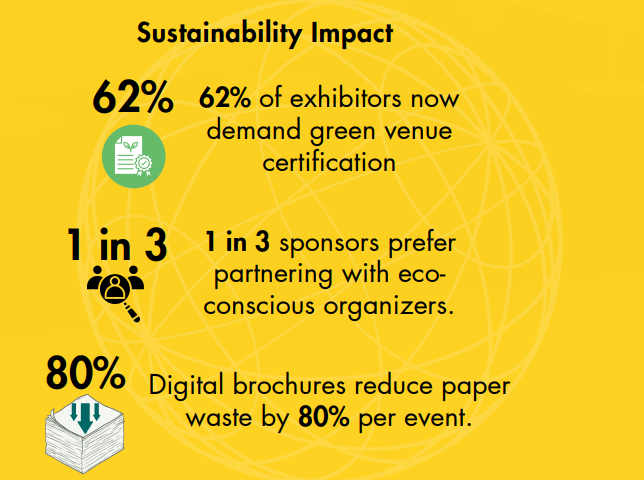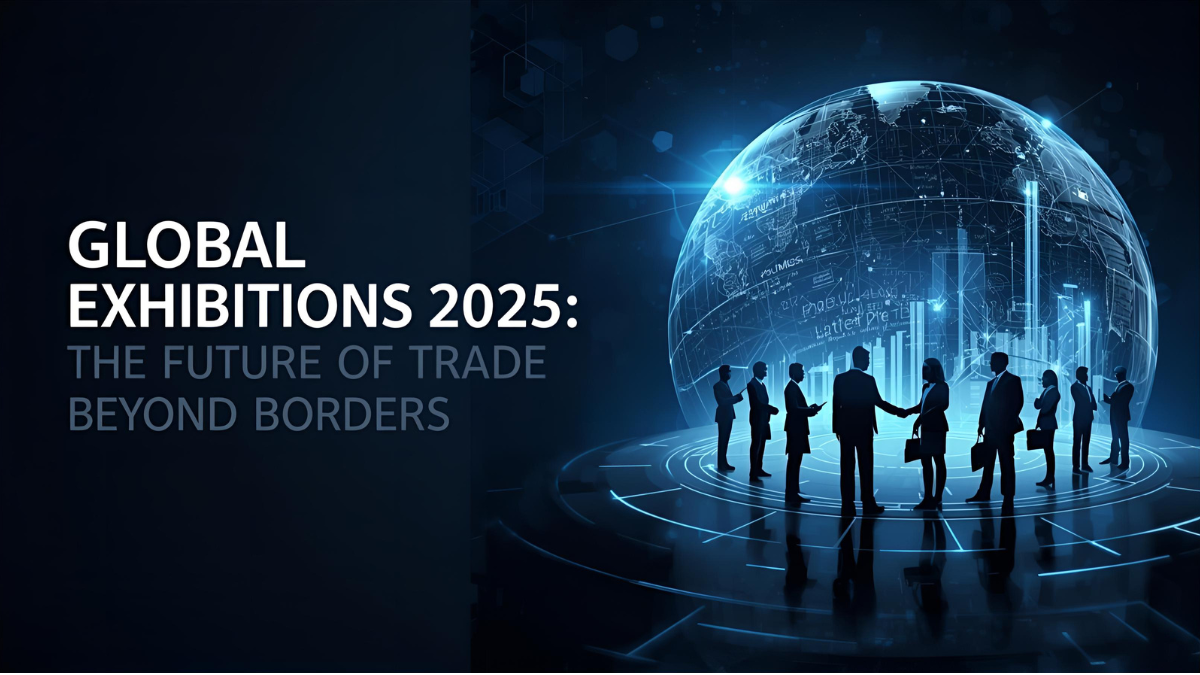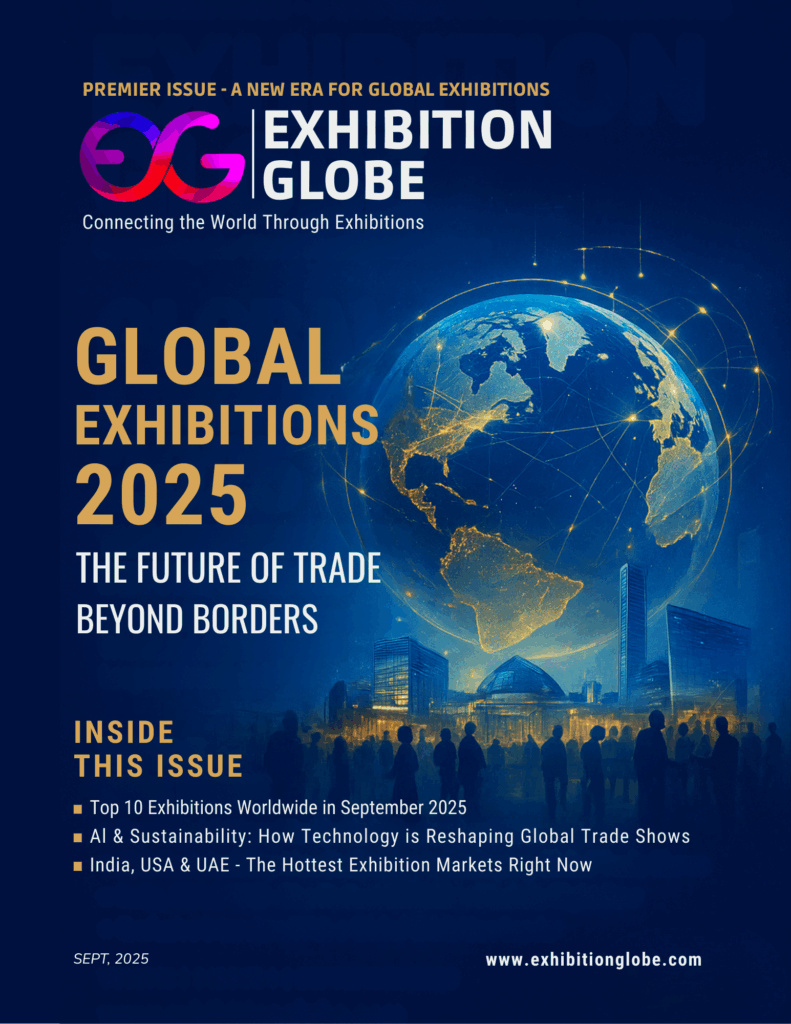Introduction: The New Dawn of Exhibitions
The global exhibition industry is at a remarkable inflection point in 2025. From bustling trade pavilions in Dubai and Shanghai to specialized B2B fairs in Berlin, Mumbai, and Chicago, exhibitions have always been about connections. But in today’s world, they are much more—gateways to innovation, engines of sustainability, and hubs for cross-border collaboration.
In 2025, exhibitions are no longer just “venues for booths.” They have become borderless marketplaces, connecting industries, nations, and cultures in ways unimaginable a decade ago. From Dubai to Singapore, from Mumbai to Las Vegas, exhibitions are shaping how trade flows, how technology is adopted, and how sustainable innovation is shared globally.
The COVID-19 years taught the industry a tough lesson: events must evolve or vanish. What emerged was a stronger, smarter, and future-ready exhibitions ecosystem that now stands at the intersection of technology, sustainability, and cross-border collaboration.
The traditional exhibition format—stalls, networking, product launches—has expanded into an ecosystem powered by digital technology, green initiatives, and a global mindset. What we are witnessing now is not just the revival of the exhibition industry post-pandemic—it is a reinvention.

1. Technology: Driving the Hybrid Future
Technology is no longer an accessory to exhibitions—it is the foundation. In 2025, organizers are embracing hybrid formats that merge physical presence with digital reach, ensuring no barrier stops global participation.
AI-Driven Experiences
Artificial Intelligence is revolutionizing matchmaking, lead generation, and visitor engagement. Platforms now recommend not only sessions to attend but also people to meet transforming chance encounters into curated opportunities.

Immersive XR & Virtual Twins
Virtual reality (VR) and augmented reality (AR) are creating “digital twins” of exhibitions. A buyer in Singapore can walk the halls of a Milan furniture expo, explore booths, and even engage in product demos—without leaving their city
Smart Venues & IoT
Convention centers worldwide are turning into smart ecosystems. Sensors monitor visitor flows, track sustainability goals (like energy and waste), and provide real-time data to exhibitors for better ROI measurement.
2. Sustainability: Exhibitions Go Green
Global exhibitions are embracing sustainability as a business imperative. Organizers, exhibitors, and venues are under growing pressure to adopt eco-conscious practices.As climate change concerns dominate global discourse, exhibitions are embracing sustainability not as a choice, but as a responsibility
Green Venues
Top convention centers in Singapore, Dubai, and Amsterdam are leading with LEED-certified designs, renewable energy, and zero-waste policies.
Eco-Friendly Booths
Exhibitors are moving away from single-use plastics and PVC-based builds. Modular, recyclable, and reusable stall designs are now the norm

Carbon-Neutral Events
Organizers are pledging carbon neutrality by offsetting travel emissions, integrating public transport incentives, and even using blockchain to track sustainability footprints.
Sustainable Supply Chains
Food courts now source local, organic produce; merchandise is eco-certified; and energy consumption is transparently tracked for accountability.
Sustainability is no longer a side note, it’s a core criterion for participation. Global buyers increasingly favor brands aligned with responsible trade.
3. Cross-Border Collaborations: Building
Trade Bridges Exhibitions have always been about connecting industries and nations. But in 2025, this collaboration is deeper, more strategic, and more inclusive.
Regional Partnerships
Asia and Africa are emerging as new exhibition powerhouses, hosting industryspecific expos that attract global buyers. Partnerships between Western organizers and Asian governments are unlocking untapped markets.
Trade Diplomacy Through Events
Global fairs are doubling as soft-power platforms where governments, chambers of commerce, and trade bodies build relationships that go beyond business—into policy, culture, and technology sharing.
SME Empowerment
Digital platforms now enable small and medium enterprises (SMEs) to participate in international exhibitions virtually, ensuring equitable access to global opportunities.
Cultural Integration
Events are not just business hubs—they are cultural showcases. From Milan Design Week celebrating global artistry to Gulfood

4. The Human Connection: Reinventing Networking
Despite all the technology, the essence of exhibitions remains human. The joy of shaking hands, the energy of a buzzing hall, the serendipity of chance encounters—all of these continue to thrive in 2025
But networking is evolving:
- AI-powered matchmaking apps set up curated meetings before events
- Wellness lounges and cultural experiences are integrated into show floors to foster informal connections.
- Cross-industry networking zones bring together professionals from unrelated sectors, sparking unexpected collaborations.
5. Looking Ahead: What’s Next Beyond 2025?
The future of exhibitions promises even more radical transformations:
- Metaverse Fairs: Persistent digital spaces where exhibitions remain “always open.”
- Global 24/7 Marketplaces: Exhibitions evolving into year-round platforms with AI curators updating leads and insights daily.
- Personalized Trade Shows: Data-driven customization where no two attendees have the same experience.
- Impact-Driven Events: Where the success of a trade show is measured not just in contracts signed, but in sustainability, inclusivity, and social impact.
Trade Beyond Borders
In 2025, global exhibitions are no longer about “showing and selling” alone—they are platforms of change, innovation, and global unity. Technology ensures inclusivity, sustainability guarantees responsibility, and cross-border collaborations build trust across nations.
The future of trade is not confined to borders it thrives beyond them.Exhibitions are leading that charge.








